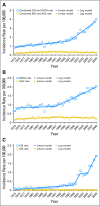Changing patterns of anal canal carcinoma in the United States
- PMID: 23509304
- PMCID: PMC3753461
- DOI: 10.1200/JCO.2012.45.2524
Changing patterns of anal canal carcinoma in the United States
Abstract
Purpose: Persistent human papillomavirus infection is associated with squamous cell carcinoma of the anal canal (SCCA). With changing sexual behaviors, SCCA incidence and patient demographics may also have changed in recent years.
Methods: The Surveillance, Epidemiology, and End Results public-use data set from 1973 to 2009 was analyzed to determine incidence trends for and demographic factors characterizing SCCA. Joinpoint analyses identified time points when incidence rates changed. For comparison, similar analyses were conducted for anal adenocarcinoma.
Results: Joinpoint analyses identified 1997 as the single inflection point among 11,231 patients with SCCA, at which the slope of incidence rates statistically increased (1997 to 2009 v 1973 to 1996: risk ratio [RR], 2.2; 95% CI, 2.1 to 2.3). Annual percent change (APC) increased for all SCCA stages and was the greatest for anal carcinoma in situ (CIS; APC, 14.2; 95% CI, 10.2 to 18.4). Demographic changes characterizing later versus earlier time period included younger age at diagnosis and rising incidence rates in all stage, sex, and racial groups. During 1997 to 2009, women were less likely to present with CIS (RR, 0.3; 95% CI, 0.3 to 0.3) but more likely to present with localized (RR, 1.2; 95% CI, 1.1 to 1.3) and regional SCCA (RR, 1.5; 95% CI, 1.4 to 1.7). In contrast, adenocarcinoma APCs among 1,791 patients remained stable during this time period.
Conclusion: CIS and SCCA incidence increased dramatically after 1997 for men and women, although men were more likely to be diagnosed with CIS. These changes likely resulted from available screening in men and argue for efforts to identify high-risk individuals who may benefit from screening.
Conflict of interest statement
Authors' disclosures of potential conflicts of interest and author contributions are found at the end of this article.
Figures

References
-
- National Cancer Institute. Anal cancer. http://www.cancer.gov/cancertopics/types/anal.
-
- American Cancer Society. Cancer Facts and Figures 2012. http://www.cancer.org/research/cancerfactsfigures/cancerfactsfigures/can....
-
- Johnson LG, Madeleine MM, Newcomer LM, et al. Anal cancer incidence and survival: The Surveillance, Epidemiology, and End Results experience, 1973-2000. Cancer. 2004;101:281–288. - PubMed
-
- Nielsen A, Munk C, Kjaer SK. Trends in incidence of anal cancer and high-grade anal intraepithelial neoplasia in Denmark, 1978-2008. Int J Cancer. 2012;130:1168–1173. - PubMed
-
- Jin F, Stein AN, Conway EL, et al. Trends in anal cancer in Australia, 1982-2005. Vaccine. 2011;29:2322–2327. - PubMed
MeSH terms
Grants and funding
LinkOut - more resources
Full Text Sources
Other Literature Sources
Medical
Molecular Biology Databases
Research Materials
Miscellaneous

